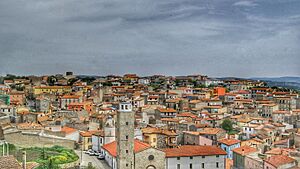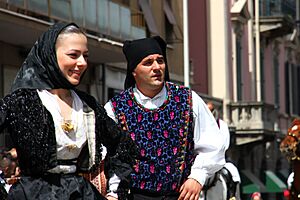Nule facts for kids
Quick facts for kids
Nule
|
|
|---|---|
| Comune di Nule | |
 |
|
| Country | Italy |
| Region | Sardinia |
| Province | Sassari (SS) |
| Area | |
| • Total | 51.95 km2 (20.06 sq mi) |
| Population
(30 November 2017)
|
|
| • Total | 1,368 |
| • Density | 26.333/km2 (68.202/sq mi) |
| Demonym(s) | Nulese |
| Time zone | UTC+1 (CET) |
| • Summer (DST) | UTC+2 (CEST) |
| Postal code |
07010
|
| Dialing code | 079 |
| Patron saint | Most Holy Child Mary |
| Saint day | September 8 |
Nule (Sardinian: Nùle) is a small town, also known as a comune (municipality), located on the beautiful island of Sardinia in Italy. It is part of the Province of Sassari, which is like a county or region. Nule is known for its quiet charm and traditional way of life.
Welcome to Nule!
Nule is a lovely place in the heart of Sardinia. It is located about 140 kilometers (87 miles) north of Cagliari, the capital city of Sardinia. It is also about 60 kilometers (37 miles) southeast of Sassari, another important city on the island.
Where is Nule?
Sardinia is a large island in the Mediterranean Sea, west of mainland Italy. Nule is nestled in the central part of the island. It shares its borders with several other towns. These include Benetutti, Bitti, Orune, Osidda, and Pattada.
People and Size
As of November 2017, Nule had a population of about 1,368 people. This makes it a small community where many people know each other. The town covers an area of about 51.95 square kilometers (20.06 square miles). This is roughly the size of a medium-sized city park. People from Nule are called "Nulese."
How Nule is Run
Like all towns in Italy, Nule is governed by a local council. The head of the town's government is called the mayor. The mayor of Nule is Antonio Giuseppe Mellino. The mayor and the council work together to manage the town's services. These services include things like roads, schools, and local events.
Local Traditions
Nule has a rich history and strong traditions. The town celebrates its patron saint, the Most Holy Child Mary, on September 8th. This is a special day for the community. During festivals, people sometimes wear traditional folk costumes. These outfits show the unique culture of the region.
See also
 In Spanish: Nule para niños
In Spanish: Nule para niños


